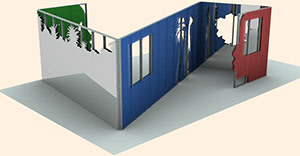Interview: Eddie Peake
Simply sign up to the Life & Arts myFT Digest -- delivered directly to your inbox.
Eddie Peake was born in London in 1981. His practice includes painting, sculpture, installation, video and photography but he is most famous for staging performances such as “Touch”, a five-a-side naked football match at the Royal Academy.
At Frieze New York he will be the subject of a solo booth at the Lorcan O’Neill gallery, which will include a performance.

What can you tell us about the Frieze performance?
It will be quite different from any I have done before. Usually, the audience shows up at a specific time in a gallery and the performance lasts around an hour and has a loose narrative structure with a beginning, middle and an end. But this piece will last a minute or two and recur throughout the fair without any announcement.
Why the change?
I don’t think an art fair is the right context for a spectacle-type performance. I want a momentary, abrasive insertion that flares up and vanishes.
Do you struggle to sell them?
No, inasmuch as I’ve never particularly tried to sell a performance! I don’t want to make any concrete rules about it, but I do like the fact that, to a large extent, performance works inherently defy that functionality, and yet feed off it too, because they can exist in the context of a fair, museum or gallery.
Some artists love to break free of those institutional spaces. Are you quite attached to them?
I’ve exhibited in a broad variety of contexts actually but inevitably the ones that garner most attention are established commercial galleries, fairs and institutions. Having said that, I do love the way galleries are so tense. It’s like a switch gets turned on when you walk in: “I am viewing. What am I viewing? What’s my position on what I am viewing?”. I find that fascinating.
Why are your performers so often naked or semi-naked?
A number of reasons, one of which is that I am interested in characters who are sexualised in a way that defies stereotypes. I love Prince, for example, and Ruby Rhod, the radio show presenter in the film The Fifth Element who seems like a flamboyant, drag-queen-style gay guy but everything he says is ferociously heterosexual.

So you like the contradiction?
But’s it’s not a contradiction! It’s totally normal. It becomes a contradiction because of the stereotypes that we impose on gender.
Why do you make art?
I’m not entirely sure but I often have ideas which could be anything from an image, a sentence, a mood, a memory, a movement, a space and so on, and then I think: “Oh that would be wonderful or beautiful or wrong. I want to do it!”
Comments